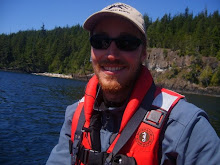
There are some pretty cool things living in the ocean. There are some pretty cool videos of things that live in the ocean, too. For instance, this video from Science News of sea urchin larvae developing into adults is pretty amazing. And in case you haven't seen it already, check out beautifully put-together video of bioluminescence in the waves near San Diago:
The light show that you see above is the result of millions of dinoflagellates (tiny marine algae) that washed ashore after a large algae bloom along the west coast. These blooms, which usually happens after an upwelling of nutrients form the deep waters off the continental shelf, is often called red tide as the algae are actually dense enough to change the colour of the seawater over a huge area. To get an idea of exactly how large an area, have a look at this satellite image of the waters off Vancouver Island in the fall of 2004. Just as these algae can change the colour of the water by day, they can also light them up by night by producing a chemical with one most wicked names known to science: LUCIFERIN.
This chemical, which in dinoflagellates is thought to be a modified form of chlorophyll, reacts in the presence of oxygen (and the catalyst, luciferase) to produce light, as below (click on the image to learn more about the chemistry):
Bioluminescence of luciferin (courtesy of Biological Science - UC Santa Barbara)
All this leads to one question: where can you buy buy sustainable local seafood, anyway? At least, that's the question on our collective minds here at Water Bloged.
The reason for this is that sustainable, locally-caught seafood is... well... bloody difficult to find at times. In fact, it's often much easier to find cheap, imported seafood options than sustainable, Canadian-caught fare. This not only frustrates sustainable-seafood lovers, but results in billions of dollars each year going to often environmentally-destructive foreign industries instead of local fishermen (many of whom fish in a responsible, sustainable fisheries).
So what's the solution? Well, Living Oceans Society has been working on the idea of a community-supported network that will allow producers of sustainable seafood to connect directly to Canadian seafood consumers. We even have a name for this endeavour: Sea to Fork.

Sound good? Good, because this is where you come in: we have registered this idea in the Aviva Community Fund, to help secure funding for this exciting project. We need as many people as possible to vote for this idea each day over the next two weeks, so that we can get into the next round. It will take you mere moments to help us make this idea a reality.

No comments:
Post a Comment